Gauss's Law Exercise (Part 2)
A cube of side length 2 is centered on the origin, with its faces perpendicular to the standard coordinate axes. A particle with charge q = + 1 0 is at position ( x , y , z ) = ( 4 1 , 2 1 , 4 3 ) .
Let the electric fluxes through the six sides of the cube be ϕ 1 , ϕ 2 , ϕ 3 , ϕ 4 , ϕ 5 , ϕ 6 . Determine the following ratio:
ϕ 1 + ϕ 2 + ϕ 3 + ϕ 4 + ϕ 5 + ϕ 6 ϕ 1 ϕ 2 ϕ 3 ϕ 4 ϕ 5 ϕ 6
Details and Assumptions:
1)
Electric permittivity
ϵ
0
=
1
2)
Use outward-facing normal vectors for the faces
The answer is 0.746.
This section requires Javascript.
You are seeing this because something didn't load right. We suggest you, (a) try
refreshing the page, (b) enabling javascript if it is disabled on your browser and,
finally, (c)
loading the
non-javascript version of this page
. We're sorry about the hassle.
2 solutions
Nice Problem as always.I will upload the solution of the integrals if asked
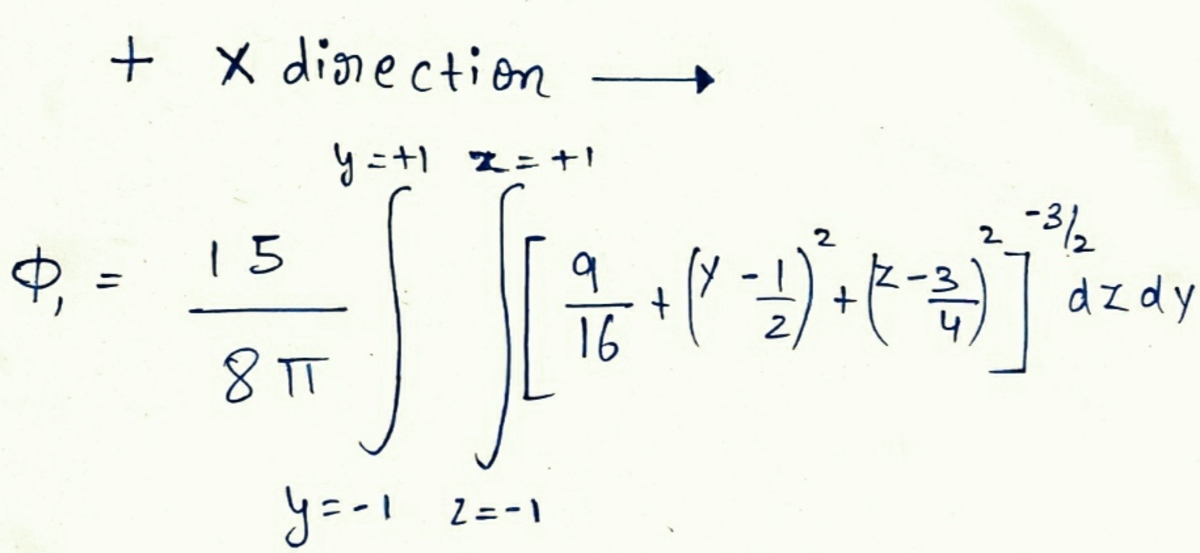
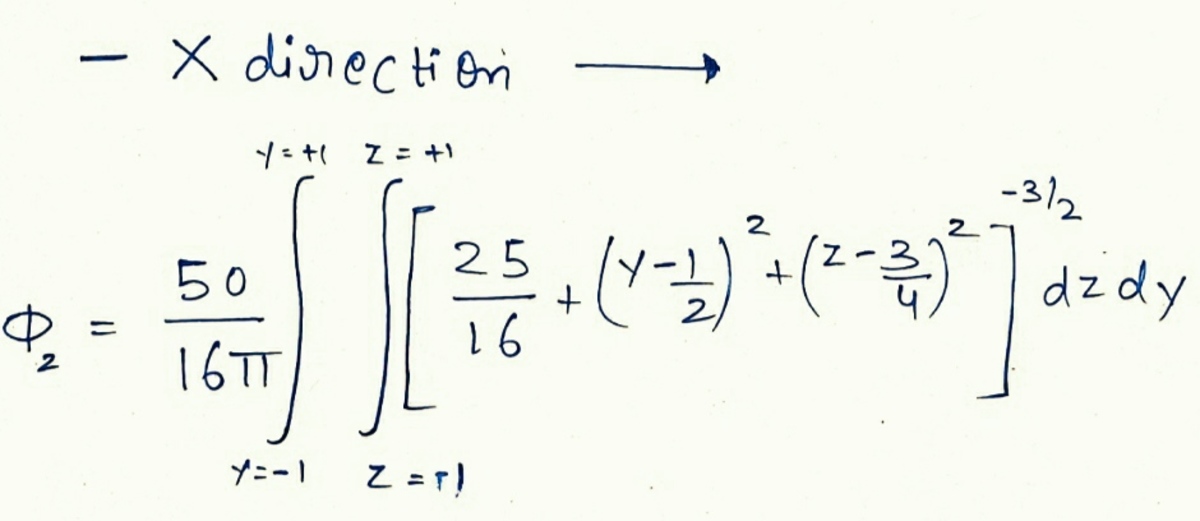
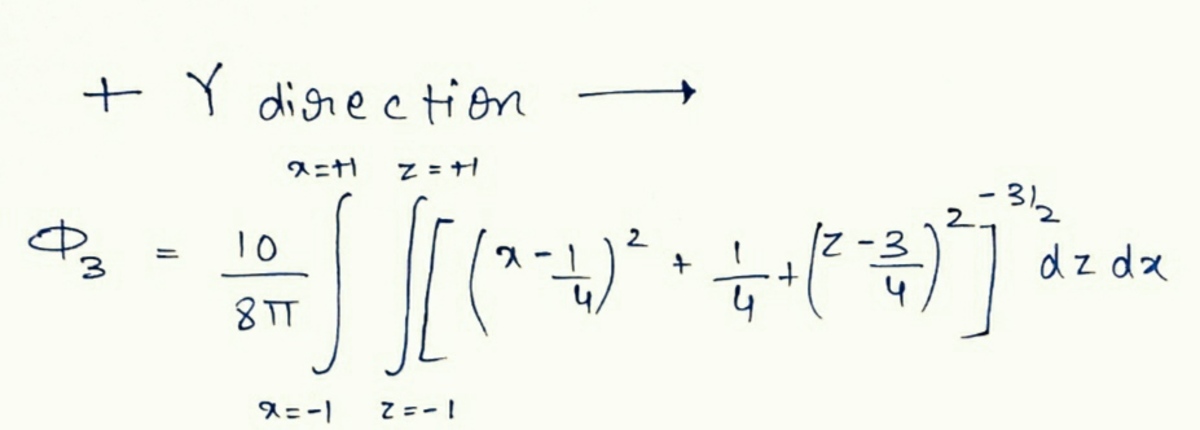
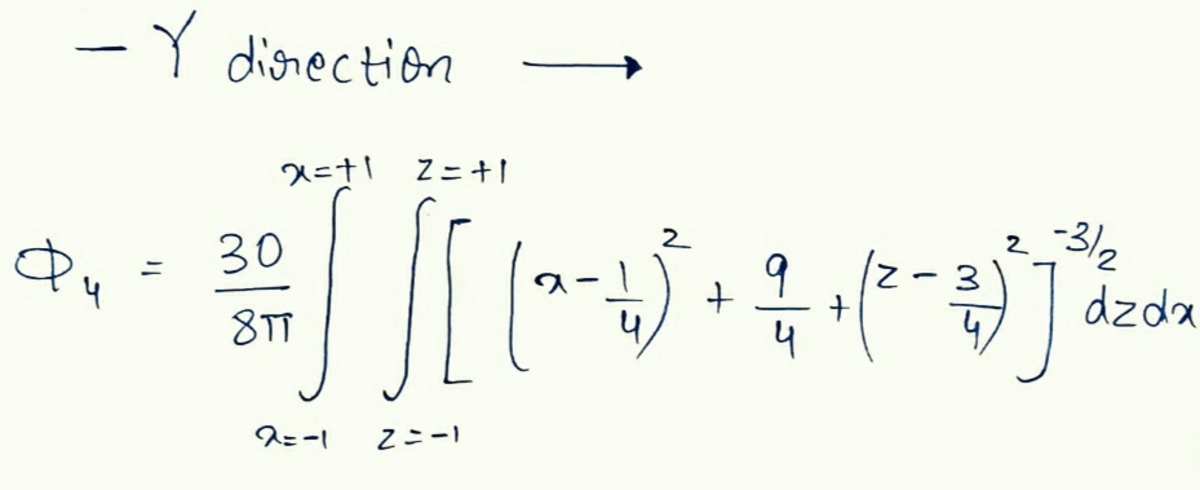
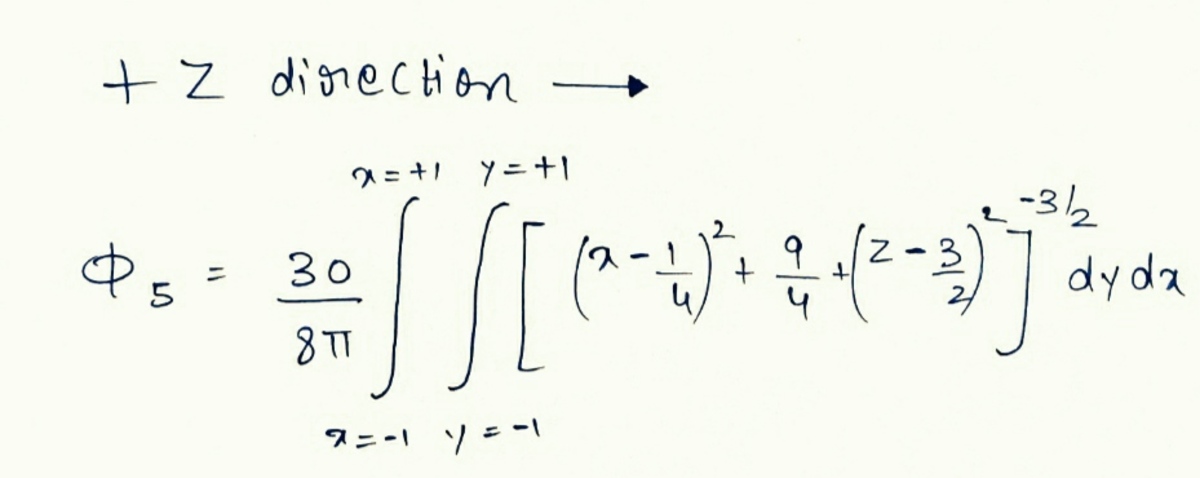
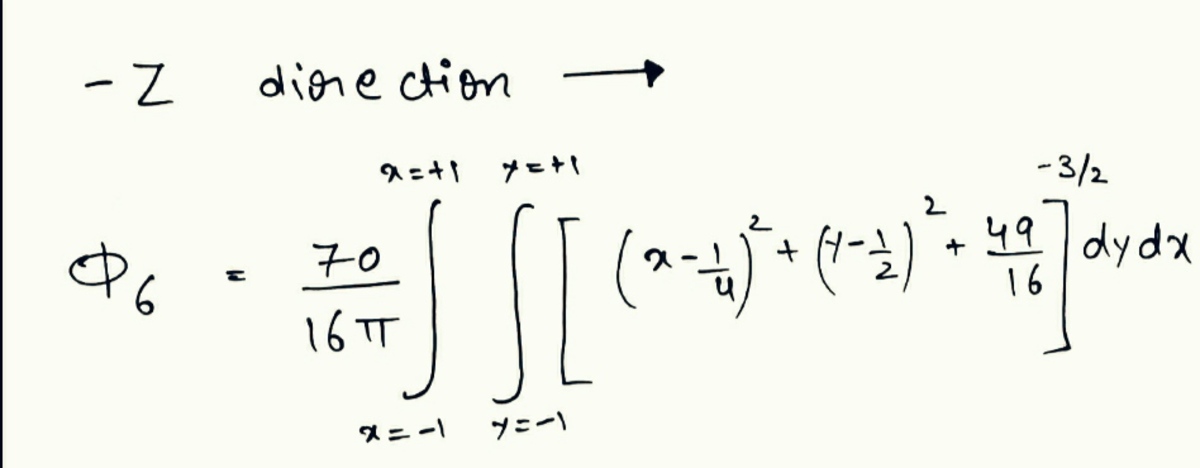
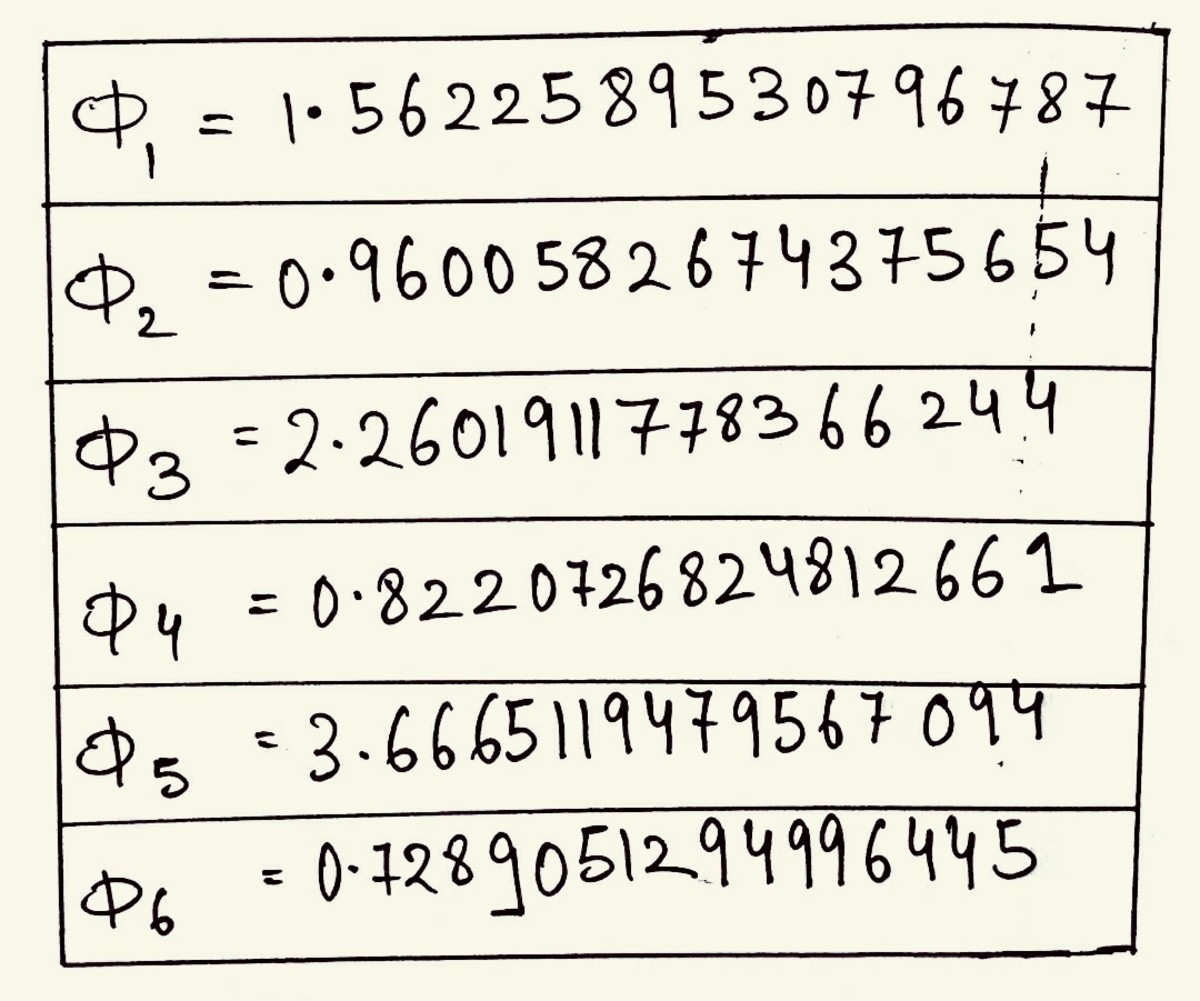
I will show the working for computing the electric flux through the plane of the cube, passing through the point ( 1 , 0 , 0 ) and which is perpendicular to the X-axis. Consider a point P on this plane. Its position vetor is:
r p = 1 i ^ + y j ^ + z k ^
The location of the charge has a position vector:
r c = 0 . 2 5 i ^ + 0 . 5 j ^ + 0 . 7 5 k ^
The vector joining these two points and directed away from the charge is:
r = r p − r c
The electric field at point P due to the point charge + q is:
E = 4 π ϵ o q ( ∣ r ∣ 3 r )
Recall that area vectors are outward normals. The surface area element on the plane is:
d S = d y d z i ^
The flux through thhis elementary area due to this electric field is:
d ϕ 1 = E ⋅ d S
Substituting and simplifying gives:
d ϕ 1 = 4 π 1 0 ⎝ ⎜ ⎛ ( ( 1 − 0 . 2 5 ) 2 + ( y − 0 . 5 ) 2 + ( z − 0 . 7 5 ) 2 ) 3 / 2 ( 1 − 0 . 2 5 ) d z d y ⎠ ⎟ ⎞
Finally,
ϕ 1 = ∫ − 1 1 ∫ − 1 1 4 π 1 0 ⎝ ⎜ ⎛ ( ( 1 − 0 . 2 5 ) 2 + ( y − 0 . 5 ) 2 + ( z − 0 . 7 5 ) 2 ) 3 / 2 ( 1 − 0 . 2 5 ) d z d y ⎠ ⎟ ⎞ ≈ 1 . 5 6 2 2 6
The above integral is computed using Wolfram-Alpha. Similarly, for other planes that make up the cube:
The plane of the cube, passing through the point ( − 1 , 0 , 0 ) and which is perpendicular to the X-axis: ϕ 2 = ∫ − 1 1 ∫ − 1 1 4 π 1 0 ⎝ ⎜ ⎛ ( ( 1 + 0 . 2 5 ) 2 + ( y − 0 . 5 ) 2 + ( z − 0 . 7 5 ) 2 ) 3 / 2 ( 1 + 0 . 2 5 ) d z d y ⎠ ⎟ ⎞ ≈ 0 . 9 6 0 0 5 8
The plane of the cube, passing through the point ( 0 , 0 , 1 ) and which is perpendicular to the Z-axis: ϕ 3 = ∫ − 1 1 ∫ − 1 1 4 π 1 0 ⎝ ⎜ ⎛ ( ( x − 0 . 2 5 ) 2 + ( y − 0 . 5 ) 2 + ( 1 − 0 . 7 5 ) 2 ) 3 / 2 ( 1 − 0 . 7 5 ) d x d y ⎠ ⎟ ⎞ ≈ 3 . 6 6 6 5 1
The plane of the cube, passing through the point ( 0 , 0 , − 1 ) and which is perpendicular to the Z-axis: ϕ 4 = ∫ − 1 1 ∫ − 1 1 4 π 1 0 ⎝ ⎜ ⎛ ( ( x − 0 . 2 5 ) 2 + ( y − 0 . 5 ) 2 + ( 1 + 0 . 7 5 ) 2 ) 3 / 2 ( 1 + 0 . 7 5 ) d x d y ⎠ ⎟ ⎞ ≈ 0 . 7 2 8 9 0 6
The plane of the cube, passing through the point ( 0 , 1 , 0 ) and which is perpendicular to the Y-axis: ϕ 5 = ∫ − 1 1 ∫ − 1 1 4 π 1 0 ⎝ ⎜ ⎛ ( ( x − 0 . 2 5 ) 2 + ( 1 − 0 . 5 ) 2 + ( z − 0 . 7 5 ) 2 ) 3 / 2 ( 1 − 0 . 5 ) d z d y ⎠ ⎟ ⎞ ≈ 2 . 2 6 0 1 9
The plane of the cube, passing through the point ( 0 , − 1 , 0 ) and which is perpendicular to the Y-axis: ϕ 6 = ∫ − 1 1 ∫ − 1 1 4 π 1 0 ⎝ ⎜ ⎛ ( ( x − 0 . 2 5 ) 2 + ( 1 + 0 . 5 ) 2 + ( z − 0 . 7 5 ) 2 ) 3 / 2 ( 1 + 0 . 5 ) d z d y ⎠ ⎟ ⎞ ≈ 0 . 8 2 2 0 7 3
I have not shown the derivation of all integrands because the process is similar to what is shown.
Therefore:
ϕ 1 + ϕ 2 + ϕ 3 + ϕ 4 + ϕ 5 + ϕ 6 ≈ 1 0 ϕ 1 ϕ 2 ϕ 3 ϕ 4 ϕ 5 ϕ 6 ≈ 7 . 4 4 7 8